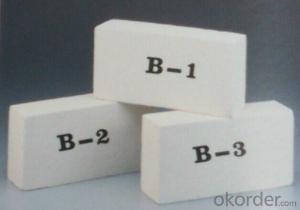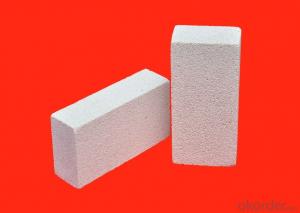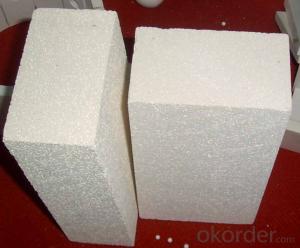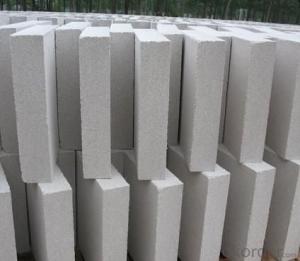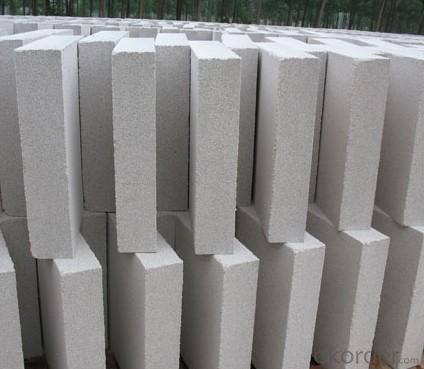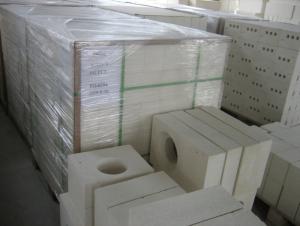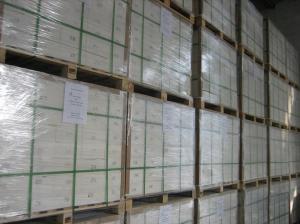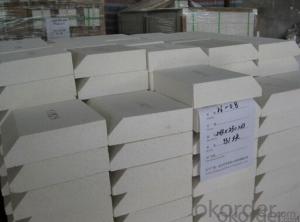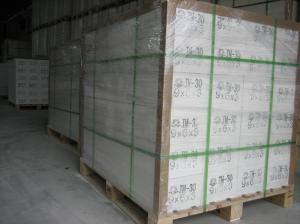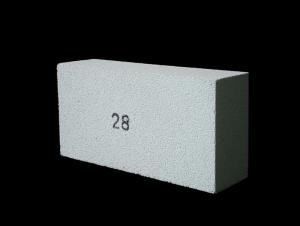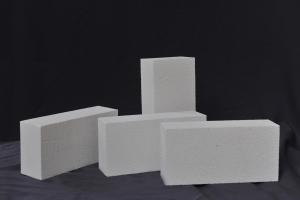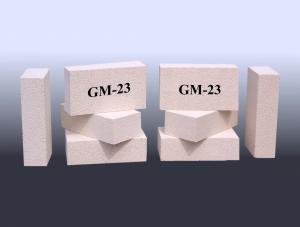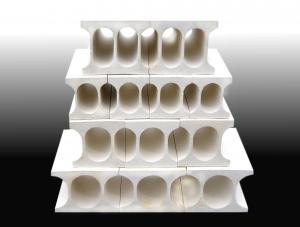Insulating Fire Brick - Refractory Mullite Insulating Refractory Brick JM 23
- Loading Port:
- Shanghai
- Payment Terms:
- TT OR LC
- Min Order Qty:
- 20 m.t.
- Supply Capability:
- 20 m.t./month
OKorder Service Pledge
OKorder Financial Service
You Might Also Like
Okorder series heat insulation brick
Okorder series thermal insulation brick is an effective, energy saving, low carbon, environmental protection advanced, according to the ASTM standard manufacturing products. Okorder series products have all kinds of materials in the field of metallurgy, industrial furnaces, aluminum, the best Li Ning petrochemical and insulation, electric power and glass ceramics. They can be used as part of an insulation or not to melt. Products have been widely used in the following furnace, achieved satisfactory results.
Application of heat preservation brick
Metallurgical Industry: blast furnace, hot blast furnace, heating furnace, etc..
Petrochemical Industry: ethylene cracking furnace, hydrogen furnace, the main furnace, heating furnace, etc..
Ceramic industry: roller kiln, kiln, etc..
Glass industry: glass furnace regenerator, etc.
Carbon industry: carbon furnace, etc..
Aluminum electrolysis industry: aluminum reduction cell, etc.
Other industries: tunnel kiln, shuttle kiln, etc..
Advantages of heat insulation brick
Low thermal conductivity: many air holes will bring good thermal insulation effect, energy saving.
High crushing strength: high crushing strength, volume stability.
Low heat storage: small heat storage, absorb more heat, energy-saving effect is obvious.
Chundu: High-speed Rail, low content of alkali metal impurities.
Accuracy: the size of the brick machining precision, cutting and grinding the special shape, speed up the brick.
Technical Data
ITEM | GJM30 | GJM28 | GJM26 | GJM23 |
Classification Temperature, ℉/℃ | 3000/1650 | 2800/1540 | 2600/1430 | 2300/1260 |
Bulk Density,g/cm³ | ≤1.0 | ≤0.9 | ≤0.8 | ≥0.5 |
Reheating Linear Change, % | ≤0.9 (1550℃,12 h) | ≤0.8 (1510℃,12 h) | ≤0.7 (1410℃,12 h) | ≤0.5 (1230℃,12 h) |
Al2O3 Content, % | ≥75 | ≥65 | ≥55 | ≥45 |
Fe2O3 Content, % | ≤0.5 | ≤0.6 | ≤0.7 | ≤1.0 |
Thermal Conductivity: | ||||
800℃, w/m.k | ≤0.39 | ≤0.37 | ≤0.35 | ≤0.18 |
1000℃, w/m.k | ≤0.43 | ≤0.41 | ≤0.39 | ≤0.20 |
1200℃, w/m.k | ≤0.48 | ≤0.46 | ≤0.43 | --- |
Insulating brick
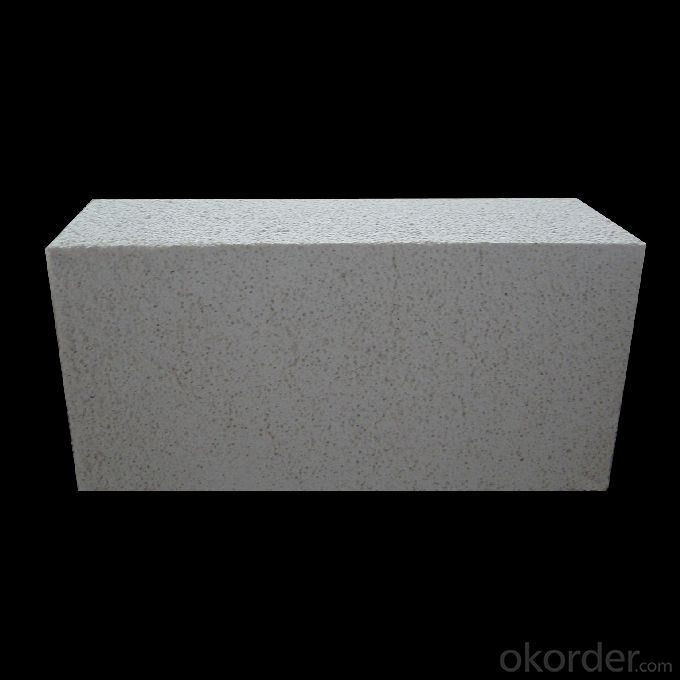
- Q: Can insulating fire bricks be used in tundish linings?
- Yes, insulating fire bricks can be used in tundish linings. Insulating fire bricks are made from lightweight refractory materials that have excellent insulating properties. Tundish linings are typically exposed to high temperatures and thermal shocks, which can lead to rapid wear and tear. By using insulating fire bricks, the tundish lining can be protected from excessive heat and thermal stresses. These bricks have low thermal conductivity, which helps to minimize heat loss and maintain a stable temperature inside the tundish. Additionally, insulating fire bricks have good mechanical strength and can withstand the mechanical stresses typically experienced in tundish operations. Overall, using insulating fire bricks in tundish linings can help to improve thermal efficiency, reduce energy consumption, and extend the service life of the tundish.
- Q: Is it necessary to abolish the technical regulations for the construction of self thermal insulation masonry building with sludge sintering insulation bricks?
- Silt sintering brick insulation brick is made from river mud, city sludge, mud as the main raw materials, added according to a certain proportion of siliceous inorganic binder after aging, extrusion blank, blank by cutting, drying, sintering and extrusion molding machine. The utility model has the advantages of energy saving, resource saving, favorable for developing circular economy and comprehensive utilization of resources, high micropore rate, good product heat insulation performance and heat insulation performance, etc..
- Q: Can insulating fire bricks be used in the construction of lime production linings?
- Yes, insulating fire bricks can be used in the construction of lime production linings. Insulating fire bricks are designed to have low thermal conductivity, which makes them excellent for applications where heat insulation is required. In lime production, high temperatures are required for the calcination process. Using insulating fire bricks in the construction of lime production linings helps to reduce heat loss and improve energy efficiency. Additionally, insulating fire bricks are lightweight and easy to handle, which makes them suitable for lining various parts of lime kilns and other equipment used in the lime production process. Overall, using insulating fire bricks in lime production linings can help to optimize the production process and improve the overall performance of lime production facilities.
- Q: Do insulating fire bricks have a high thermal shock resistance?
- Yes, insulating fire bricks typically have a high thermal shock resistance. These bricks are specifically designed to withstand rapid changes in temperature without cracking or breaking. They are made from lightweight refractory materials that have low thermal conductivity, which helps to minimize heat transfer and prevent thermal stress. Additionally, insulating fire bricks often go through a firing process that further enhances their thermal shock resistance. Overall, these bricks are well-suited for applications where they are exposed to extreme temperature fluctuations, making them a reliable choice for insulation in high-temperature environments.
- Q: Can insulating fire bricks be used in ceramic fiber modules?
- Insulating fire bricks cannot be utilized in ceramic fiber modules, as their compositions and constructions greatly differ. Insulating fire bricks are composed of dense refractory materials, typically containing high levels of alumina and silica. These materials offer exceptional thermal insulation and high temperature resistance. Conversely, ceramic fiber modules are made of lightweight, flexible ceramic fibers that provide superior thermal insulation properties. They are primarily used to line furnaces, kilns, and other high-temperature applications. Insulating fire bricks are solid and rigid, whereas ceramic fiber modules are flexible and can be easily molded and installed. Therefore, trying to incorporate insulating fire bricks into ceramic fiber modules would not only be impractical but also ineffective in achieving the desired insulation properties and overall performance. To ensure safety, efficiency, and longevity, it is crucial to use materials specifically designed for their intended applications.
- Q: Can insulating fire bricks be used in the construction of glass melting tanks?
- Yes, insulating fire bricks can be used in the construction of glass melting tanks. Insulating fire bricks are specifically designed to withstand high temperatures and provide excellent insulation properties. This makes them ideal for use in glass melting tanks, where extreme temperatures are required to melt the glass. The insulating properties of these bricks help to minimize heat loss and maintain the desired temperature within the tank, resulting in more efficient and cost-effective glass melting processes. Additionally, insulating fire bricks are durable and resistant to thermal shock, making them a reliable choice for the construction of glass melting tanks.
- Q: Can insulating fire bricks reduce heating or cooling costs?
- Yes, insulating fire bricks can help reduce heating or cooling costs. These bricks are specially designed to have a high level of thermal insulation, meaning they have low thermal conductivity and can effectively prevent heat transfer between the inside and outside of a building. When used in the construction of fireplaces, ovens, or kilns, insulating fire bricks can help retain heat within these structures, allowing them to reach and maintain higher temperatures with less energy consumption. This can lead to significant savings on heating costs, as less energy is required to achieve the desired temperature. Similarly, when used in the construction of walls, insulating fire bricks can help minimize heat transfer between the interior and exterior of a building. This can result in reduced heating or cooling needs, as the insulation helps to maintain a more stable indoor temperature. As a result, less energy is required to heat or cool the building, leading to lower energy bills and reduced overall heating or cooling costs. It is important to note that the effectiveness of insulating fire bricks in reducing heating or cooling costs can vary depending on various factors, such as the overall insulation of the building, the size and design of the structure, and the climate in which it is located. However, in general, using insulating fire bricks can contribute to energy efficiency and cost savings in heating or cooling systems.
- Q: Can insulating fire bricks be used for fireplace lining?
- Yes, insulating fire bricks can be used for fireplace lining. These bricks are designed to withstand high temperatures and provide excellent insulation, making them suitable for lining the inside of a fireplace. They help to retain heat and improve the efficiency of the fireplace while protecting the surrounding structure from excessive heat.
- Q: Can insulating fire bricks be used for insulation in steam boilers?
- Yes, insulating fire bricks can be used for insulation in steam boilers. These bricks are specifically designed to withstand high temperatures and provide excellent thermal insulation properties. They help to reduce heat loss and improve the overall energy efficiency of the steam boiler system.
- Q: What is the recommended method for installing insulating fire bricks?
- To achieve proper insulation and structural integrity, it is recommended to follow these steps when installing insulating fire bricks: 1. Surface Preparation: Prior to installation, ensure that the surface is clean and free from debris. Remove any loose or damaged bricks from the area. 2. Measurement and Planning: Measure the installation area and plan the layout accordingly, considering any special cutting or shaping required for openings or corners. 3. Brick Cutting: Use a diamond blade saw or masonry saw to cut the insulating fire bricks into the desired size and shape. When doing so, wear appropriate protective gear such as safety goggles and a dust mask. 4. Adhesive Application: Apply a thin layer of refractory adhesive or mortar onto the surface where the first brick will be placed. Use a trowel or notched trowel to spread the adhesive evenly. 5. Brick Placement: Carefully place the first brick onto the adhesive, ensuring it is firmly pressed into place. Check that it is level and aligned with the adjacent bricks. Repeat this step for the remaining bricks, leaving a small gap between each for expansion. 6. Gap Filling: Fill the gaps between the bricks with refractory mortar, using a trowel or grout bag. Press the mortar firmly to create a tight seal. 7. Curing Time: Allow the adhesive and mortar to cure for the recommended duration, typically 24 to 48 hours. This ensures a secure bond and readiness for use. 8. Testing and Insulation: After the curing period, gently tap the bricks to check for stability. Once confirmed, proceed with insulating the surrounding area if necessary, following the manufacturer's instructions. Always refer to the manufacturer's instructions for the specific insulating fire bricks, adhesive, or mortar being used. If unsure about any step, consulting a professional or experienced installer is advisable.
Send your message to us
Insulating Fire Brick - Refractory Mullite Insulating Refractory Brick JM 23
- Loading Port:
- Shanghai
- Payment Terms:
- TT OR LC
- Min Order Qty:
- 20 m.t.
- Supply Capability:
- 20 m.t./month
OKorder Service Pledge
OKorder Financial Service
Similar products
Hot products
Hot Searches
Related keywords
